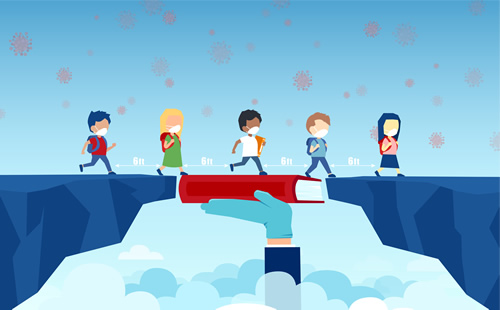
Has the pandemic widened the achievement gap?
What can the results of 5.3 million student assessments tell us about the state of educational equity in the COVID-19 era?
By Dr. Katie McClarty, Vice President of Research and Design, Renaissance March 5th, 2021Educators have been talking about the achievement gap since at least the 1960s and the publication of the Coleman Report. This year, of course, the gap everyone is focused on is between where we would expect students to be in a typical school year and where they are now, given all the learning disruptions of the past year.
But what happens when those gaps combine, as they have for millions of students around the country? Has the pandemic—and the varied responses to it—exacerbated the achievement gap?
To find out, we looked at 5.3 million assessments from students who took Star Early Literacy, Star Reading, or Star Math assessments in both fall 2019 and fall 2020. At first glance, the findings from How Kids Are Performing did not seem as dire as some initial predictions. With a little perspective, however, the results point to a lot of work ahead for educators and students.
Cause for concern
If the pandemic affected all students more or less the same, at least in terms of building closures and access to school, everyone should be at the same disadvantage, right?
Maybe, but the pandemic didn’t affect everyone’s access to learning in the same way. Different states had different policies, as did different school districts. Individual students have different personal situations, such as siblings to care for, lack of proper nutrition at home, a chaotic home life, or any number of other complications that become magnified when school happens at home. And, of course, individual students may not have access to the internet, which, during the pandemic, can mean no access to books, libraries, other learning resources, or even a teacher.
Given those disparities, we thought it was important to see if there was a differential impact on different groups of students.
The findings
The short answer is, “Yes. There has been an observable, differential impact on some student groups.”
All students were impacted somewhat by the pandemic and its attendant learning disruptions, but those effects tended to be toward the lower end of prior predictions. On average, reading performance was only a single percentile lower than we’d expect to see in a more typical school year. Math achievement was affected more significantly, at an average of seven percentage points below expectations.
Among the groups more affected by learning disruptions, the differences tended to be minor, one or two percentage points more than the average. Those groups included:
● Black, Hispanic, and Native American students
● Students who attend schools that serve high-poverty populations
● Students who attend public rather than private schools
● Students in rural or small towns as opposed to suburban or urban schools
Despite the fact that these groups of students experienced slightly more learning losses than the general student population, those additional differences were small compared with the existing achievement gaps.
Clarifying context
The findings for both all students and at-risk students may feel like good news. And to a certain extent, they are! There were plenty of dire predictions made last spring about the coming learning loss that doesn’t seem to be borne out by these results.
However, there is still plenty of work to be done. While these findings may not reflect the gloomiest outcomes we were contemplating at the beginning of the pandemic, they also come from the beginning of the school year. Several months later, many students remain in remote learning environments and are likely experiencing some continuing learning loss.
Compounding the issue, different states and districts have continued with disparate responses, and individual students continue to struggle with barriers magnified by the pandemic that many of their peers do not have to deal with.
We are continuing to analyze the data as students are assessed throughout the school year. What we can be sure of now, however, is that the pandemic has affected student learning, and at-risk students are more likely to be affected, but the current magnitude of the setbacks are largely manageable through appropriate assessment and instruction.
A path forward
The path forward may lie, counterintuitively, with a group of students not traditionally seen as at-risk, but that has experienced a differential impact of its own. Of all elementary and middle school students, fifth graders showed the largest impact of building closures in mathematics. Further, fifth grade is when students typically encounter fraction concepts that are some of the most difficult challenges students face during their academic careers. We know from decades of research that students who miss out on mastering these concepts tend to struggle with math throughout middle and high school.
We refer to skills like these—those that are critical prerequisites for future learning—as Focus Skills. While all standards are important, these skills are absolutely vital to student success. Emphasizing these skills can accelerate student learning and fill the most critical gaps.
There’s plenty of work to do moving forward, but the challenge is the same as ever: to meet students where they are and show them the way forward.
About the Author:Dr. Katie McClarty is the vice president of research and design at Renaissance, where she oversees research, psychometrics, and content development. She is co-editor of the book Preparing Students for College and Careers: Theory, Measurement, and Educational Practice. Dr. McClarty earned her Ph.D. from the University of Texas at Austin and her MBA from the Carlson School of Business at the University of Minnesota. She can be reached at katie.mcclarty@renaissance.com.
To help educators identify the Focus Skills their students need additional support with, whether they are from the student’s current grade or maybe something that got missed in last year’s shift to remote learning, Renaissance has provided a collection of resources breaking down Focus Skills by grade and state.